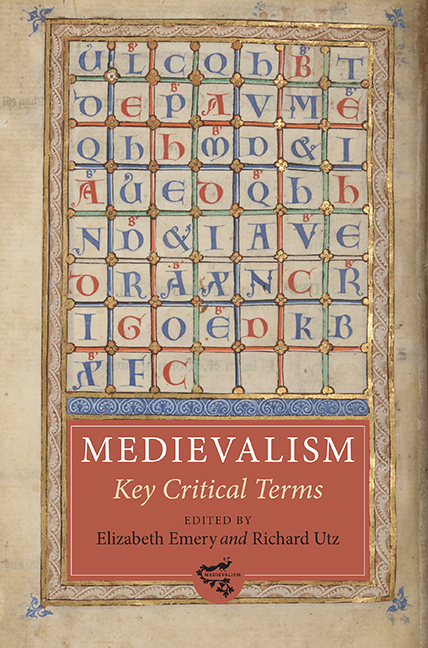Book contents
- Frontmatter
- Dedication
- Contents
- List of Illustrations
- List of Contributors
- Making Medievalism: A Critical Overview
- 1 Archive
- 2 Authenticity
- 3 Authority
- 4 Christianity
- 5 Co-disciplinarity
- 6 Continuity
- 7 Feast
- 8 Genealogy
- 9 Gesture
- 10 Gothic
- 11 Heresy
- 12 Humor
- 13 Lingua
- 14 Love
- 15 Memory
- 16 Middle
- 17 Modernity
- 18 Monument
- 19 Myth
- 20 Play
- 21 Presentism
- 22 Primitive
- 23 Purity
- 24 Reenactment
- 25 Resonance
- 26 Simulacrum
- 27 Spectacle
- 28 Transfer
- 29 Trauma
- 30 Troubadour
- Index
- Medievalism
22 - Primitive
Published online by Cambridge University Press: 08 October 2022
- Frontmatter
- Dedication
- Contents
- List of Illustrations
- List of Contributors
- Making Medievalism: A Critical Overview
- 1 Archive
- 2 Authenticity
- 3 Authority
- 4 Christianity
- 5 Co-disciplinarity
- 6 Continuity
- 7 Feast
- 8 Genealogy
- 9 Gesture
- 10 Gothic
- 11 Heresy
- 12 Humor
- 13 Lingua
- 14 Love
- 15 Memory
- 16 Middle
- 17 Modernity
- 18 Monument
- 19 Myth
- 20 Play
- 21 Presentism
- 22 Primitive
- 23 Purity
- 24 Reenactment
- 25 Resonance
- 26 Simulacrum
- 27 Spectacle
- 28 Transfer
- 29 Trauma
- 30 Troubadour
- Index
- Medievalism
Summary
IN THE MEDIEVALIST imaginary of the nineteenth century the medieval artist was often considered either as “primitive” or as a primitif. Although closely related, each of these terms was associated with specific values, and was in many ways directly opposed to the other. Until the age of modern scholarship the notion of the primitive and the primitif colored the reception of medieval works, the historiography of medieval art, and the practice of contemporary artists who attempted to emulate the spirit of the Middle Ages in their own productions. Moreover, the child-like and unsophisticated nature of the medieval artist was seen as an embodiment of the entire medieval mindset.
First and foremost, we must understand the formation of these tropes as part of the larger Western fascination for the primitive, arising in response to modern industrialized culture. Mark Antliff and Patricia Leighten have noted of the primitive that “The condition of ‘timelessness’ bestowed on the primitive also connotes the ‘primeval,’ for by not changing, the ‘primitive’ is necessarily in opposition to all that does change or develop, namely the ‘civilized.’” The child-like and ahistorical nature attributed to Western civilization's Other is very much at play in these constructions.
Although the term primitif is French, it was utilized in Germany and Italy, as well as many other European nations, in the nineteenth century. The primitif was characterized above all by his naiveté, his innocence, and his profound Catholic devotion. Most often a painter-monk or manuscript illuminator, the primitif was thought to create art out of a sense of spiritual piety, and in an environment free from material temptation, indifferent to individual recognition. In 1894, the Dutch artist Jan Verkade, once a member of the avant-garde Nabi group, wrote:
The Middle Ages believed in God, put their trust in the merits of Christ and the intercession of the Blessed Virgin and Saints, and found joy in their festivals. Of this the cathedrals, the paintings of the Madonna, the figures of the Saints, and the mystery plays all tell us.
Not surprisingly, such discourse often focused on medieval artists who had entered the monastery or Church, the better to serve their Christian inspiration.
- Type
- Chapter
- Information
- Medievalism: Key Critical Terms , pp. 189 - 198Publisher: Boydell & BrewerPrint publication year: 2014

